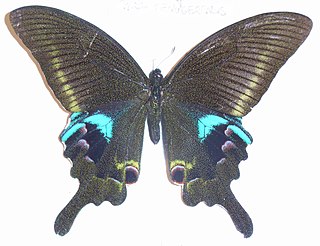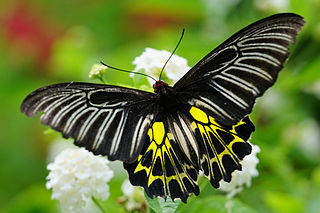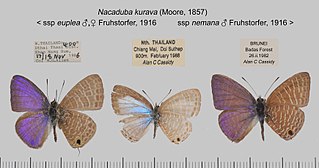Description
Male upperside: dull white, the veins black. Forewing at base and along the costal margin lightly irrorated (speckled) with black scales; a black medial transverse bar with even parallel sides across the cell, and a broader black bar on the discocellulars, this latter with a more or less outwardly curved exterior edge; beyond this a bisinuate discal and an outwardly curved postdiscal transverse black band, both extended from the costa to vein 1; the discal band generally more or less obsolescent and ill-defined below veins 3 or 4, but well marked between veins 1 and 2; the outer edge of the postdiscal band with a tendency to be very narrowly continued outwards along the veins; terminal margin dusky subhyaline (almost glass-like) black, bounded by an anteciliary jet-black slender line; cilia dusky black. Hindwing: base and dorsum broadly and heavily shaded with black, sparsely covered with long recumbent white hairs that become fuscous along the extreme edge of the dorsum; the black occupies the basal half of the cell and extends along the lower margin of its apical half to bafie of vein 4, from whence it narrows and is carried obliquely down to near the tornal angle; beyond the cell there are two black-encircled red spots, one in interspace 5, the other in interspace 7; these are followed by a postdiscal, generally complete, curved series of black lunular marks and a narrow terminal dusky-black band, bounded by an anteciliary jet-black line as on the forewing; cilia yellowish white. Underside: with the usual glassy appearance, the markings of the upperside showing through by transparency; the following, however, are marked more or less by actual scaling: the medial and apical black cellular bars on the forewing; the red black-encircled spots on the hindwing, with three additional red spots outwardly margined with black at the base of the same wing, the posterior two of these basal red spots are large and somewhat pear shaped. Antenna, head, thorax and abdomen black; the head above fuscous; beneath: the palpi, thorax and abdomen with dusky fuscous pubescence, mixed on the thorax and abdomen with long white hairs.
Female similar, but in the specimen in the collection of the British Museum marked as the type, on the upperside of the hindwing the red in the discal spot in interspace 5 has disappeared, the same colour in the spot in interspace 7 is reduced to a minute speck, and on the underside the middle red spot of the basal three only is present, much reduced in size. Antennae, head, thorax and abdomen as in the male. [1]

Papilio arcturus, the blue peacock, is a species of swallowtail butterfly found in the Indian subcontinent.

Papilio bootes, the tailed redbreast, is a swallowtail butterfly found in Asia. Within their wide distribution about four population variants have been named as subspecies. They have been placed within the Menelaides clade by a 2015 phylogenetics study.

Troides aeacus, the golden birdwing, is a large tropical butterfly belonging to the swallowtail family, Papilionidae.

Meandrusa payeni, the yellow gorgon, is a species of swallowtail found in parts of South Asia and Southeast Asia. It belongs to the hooked swallowtails genus, Meandrusa, of the family Papilionidae. It is also called the outlet sword or the sickle.

Papilio (Chilasa) agestor, the tawny mime, is a swallowtail butterfly, native to Indian subcontinent and widely found across Asia. The butterfly belongs to the mime subgenus, Chilasa, of the genus Papilio or the black-bodied swallowtails.

Papilio (Chilasa) epycides, the lesser mime, is a swallowtail butterfly found in India and parts of South-East Asia. The butterfly belongs to the mime (Chilasa) subgenus or the black-bodied swallowtails. It is a mimic of a common Indian Danainae, the glassy tiger butterfly.

Graphium mandarinus, the spectacle swordtail, which is native to India, is a butterfly of the swallowtail family (Papilionidae). It belongs to subgenus Pazala of the swordtails, that is, genus Graphium.

Parnassius stoliczkanus, the Ladakh banded Apollo, is a rare high-altitude butterfly which is found in Central Asia. It is a member of the snow Apollo genus (Parnassius) of the swallowtail family. It is named after the naturalist and explorer Ferdinand Stoliczka.

Parnassius charltonius, the regal Apollo, is a high-altitude butterfly which is found in India. It is a member of the snow Apollo genus (Parnassius) of the swallowtail family (Papilionidae). This handsome butterfly is found at altitudes from 9,000 to 13,000 feet from Chitral to Kumaon.

Parnassius acco, the varnished Apollo, is a high-altitude butterfly found in Asia. It is a member of the snow Apollo genus Parnassius of the swallowtail family, Papilionidae.

Parnassius hardwickii, the common blue Apollo, is a high-altitude butterfly which is found in South Asia. It is a member of the snow Apollo genus (Parnassius) of the swallowtail family (Papilionidae). This butterfly is found from the Chitral District to Sikkim and is found from 6,000 to 17,000 feet, making it one of the most commonly encountered species of Apollo in the Indian subcontinent.

Parnassius jacquemontii, the keeled Apollo, is a high altitude butterfly which is found in India and Pakistan. It is a member of the snow Apollo genus (Parnassius) of the swallowtail family (Papilionidae). It is also fairly common at high altitudes from Chitral to Kumaon.

Parnassius epaphus, the common red Apollo, is a high altitude butterfly which is found in India and Nepal. It is a member of the snow Apollo genus (Parnassius) of the swallowtail family (Papilionidae). It is found from 9,000 to 13,000 feet from Chitral District to Sikkim and western regions of Nepal. It is not considered rare.

Parnassius staudingeri hunza, the Karakoram banded Apollo, is a high-altitude butterfly which is found in India. It is a member of the genus Parnassius of the swallowtail family, Papilionidae. It was variously treated as a subspecies of P. delphius and a distinct species. The subspecies was first described by Grigory Grum-Grshimailo in 1888.

Azanus jesous, the African babul blue or topaz-spotted blue, is a small butterfly found in Africa, Egypt, Syria, India, Sri Lanka and Myanmar that belongs to the lycaenids or blues family.

Niphanda cymbia, the pointed Pierrot, is a small butterfly found in northern India, Burma and northern Borneo that belongs to the lycaenids or blues family.

Lycaenopsis marginata, the margined hedge blue, is a small butterfly found in India that belongs to the lycaenids or blues family.

Nacaduba kurava, the transparent six-line blue, is a species of butterfly in the family Lycaenidae found in Asia and Australia. The species was first described by Frederic Moore in 1857.

Nacaduba hermus, the pale four-line blue, is a species of lycaenid butterfly found in Indomalayan realm. The species was first described by Baron Cajetan von Felder in 1860.

Catochrysops strabo, the forget-me-not, is a small butterfly found in Asia that belongs to the lycaenids or blues family. The species was first described by Johan Christian Fabricius in 1793. It is found in Sri Lanka, India, from Sikkim to Indochina and in Sundaland, Sulawesi and the Philippines.




















